Unlimited 5 Year Endurance: The 100TB SSD from Nimbus Data
by Anton Shilov on March 19, 2018 10:45 AM EST- Posted in
- SSDs
- Storage
- NAND
- Enterprise SSDs
- Nimbus Data
- DC100
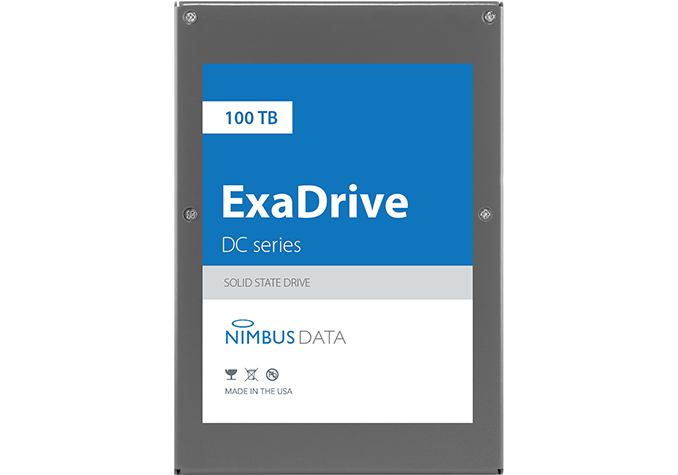
Nimbus Data on Monday introduced its new lineup of ultra-high capacity SSDs designed to compete against nearline HDDs in data centers. The ExaDrive DC drives use proprietary controllers and NAND flash in custom packaging to offer up to 100 TB of flash memory capacity in a standard 3.5-inch package. The SSDs use the SATA 6 Gbps interface and are rated for 'unlimited' endurance.
The Nimbus ExaDrive DC lineup will consist of two models featuring 50 TB and 100 TB capacities, a 3.5-inch form-factor, and a SATA 6 Gbps interface. Over time the manufacturer expects to release DC-series SSDs with an SAS interface, but it is unclear when exactly such drives will be available. When it comes to performance, the Nimbus DC SSDs are rated for up to 500 MB/s sequential read/write speeds as well as up to 100K read/write random IOPS, concurrent with most SATA-based SSDs in this space. As for power consumption, the ExaDrive DC100 consumes 10 W in idle mode and up to 14 W in operating mode.
The ExaDrive DC-series SSDs are based on Nimbus’ proprietary architecture, featuring four custom NAND controllers and a management processor. The drives use 3D MLC NAND flash memory made by SK Hynix in proprietary packaging. Nimbus does not disclose the ECC mechanism supported by the controllers, but keeping in mind that we are dealing with a 3D MLC-based device, it does not need a very strong ECC for maximum endurance.
Speaking of endurance, it is worth noting that the 100 TB drive comes with an unlimited write endurance guarantee for the full five-year warranty period. This is not particularly surprising because it is impossible to write more than 43.2 TB of data per 24 hours at 500 MB/s, which equates to 43% of the 100TB drive. For those wondering, at that speed for five years comes to ~79 PB over the 5 year warranty of the drive (assuming constant writes at top speed for five years straight).
The drives support end-to-end CRC as well, with UBER specified as <1 bit per 10^17 bits read.
The Nimbus ExaDrive DC SSDs come in industry-standard 3.5-inch form-factor and are compatible with numerous SATA backplanes capable of supporting drives with at least 14 W power consumption. In particular, Nimbus Data says that there are "at least" three vendors of 4U90 chassis with proper thermal and power characteristics to support ExaDrive DC drives and the company has already qualified them. Keeping in mind that not all ultra high density enclosures can support 14 W drives because of power and cooling requirements, the ExaDrive DCs are not drop-in compatible with every application that use 3.5-inch hard drives today. So, if a datacenter operator wants to replace some of its high capacity HDDs with ultra-high capacity SSDs and maximize its storage per square meter density, it will need to use appropriate enclosures. In fact, Nimbus plans to announce high-density reference designs with enclosure partners in the coming weeks, but the company does not elaborate.
| Nimbus Data ExaDrive DC Specifications | |||
| 50 TB | 100 TB | ||
| Form Factor | 3.5" | ||
| Interface | SATA 6 Gbps | ||
| Controller | Four proprietary controller ASICs featuring a management processor | ||
| NAND | SK Hynix 3D MLC in proprietary packaging | ||
| Sequential Read | 500 MB/s | ||
| Sequential Write | 500 MB/s (= 43 TB/day) | ||
| Random Read (4 KB) IOPS | 100,000 | ||
| Random Write (4 KB) IOPS | 100,000 | ||
| Power | Idle | 10 W | |
| Operating | 14 W | ||
| ECC | unknown | ||
| Endurance | Unlimited DWPD for over five years (limited by performance) | ||
| Uncorrectable Bit Error Rate | <1 bit per 1017 bits read | ||
| End-to-End Data Protection | Yes | ||
| Warranty | Five years | ||
| Power Loss Protection | Yes | ||
| Additional Information | Link | ||
According to Nimbus, 40 million 3.5-inch nearline HDDs with an aggregate capacity of 250 million TBs were shipped in 2017. The company believes that 10% of newly sold nearline capacity will move to NAND flash within three years, which represents massive opportunities for high capacity SSDs like the ExaDrive DC.
Nimbus has already begun sampling its DC-series SSDs with select customers. Commercial shipments are expected to begin this summer. Since Nimbus not only sells drives directly to its >200 clients, but also makes them available through its partners like Viking or Smart, and we expect other brands to offer products similar with the ExaDrive DC in the future. So far no formal announcements have been made.
The manufacturer does not disclose pricing of the ExaDrive DC50 and DC100 SSDs, but only says it will be competitive. Keep in mind that since NAND flash pricing tends to fluctuate, only time will tell actual MSRPs of the ExaDrive SSDs when they ship this summer.
Related Reading
- Viking Ships UHC-Silo SSDs: 25 - 50 TB Capacity, Custom eMLC, SAS, $0.4 per GB
- Samsung’s PM1633a Now Available: $10k for 15 TB, $6k for 7 TB
- NGD Launches Catalina: a 24 TB PCIe 3.0 x4 SSD with 3D TLC NAND
- Seagate Introduces 10GB/s PCIe SSD And 60TB SAS SSD
- Samsung’s SSD 850 EVO 4 TB Now Available from Major Retailers
Source: Nimbus Data


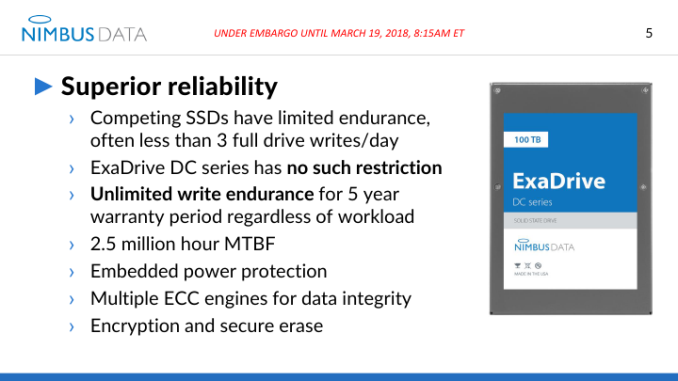
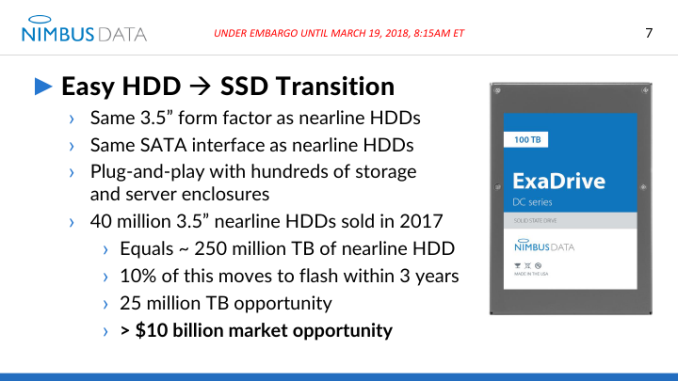
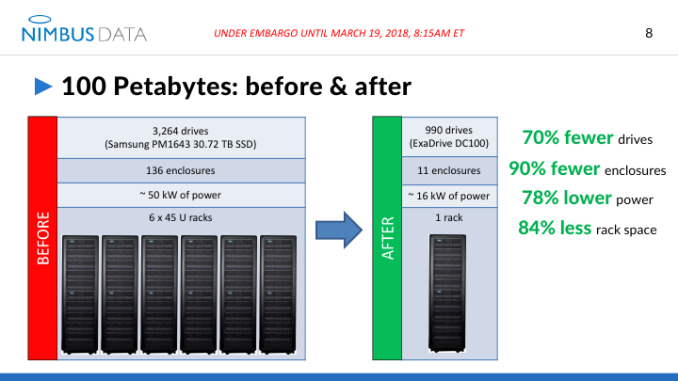
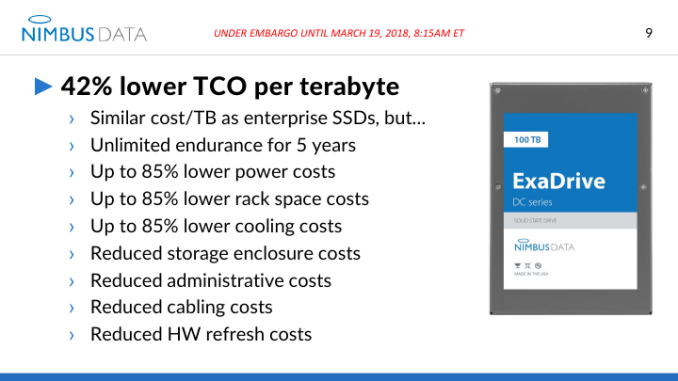














25 Comments
View All Comments
ಬುಲ್ವಿಂಕಲ್ ಜೆ ಮೂಸ್ - Monday, March 19, 2018 - link
"probably" and "as tested" are two completely different thingschaos215bar2 - Monday, March 19, 2018 - link
So test it, but you're speculating about things that have nothing to do with the drive and everything to do with the filesystem and use case. This drive is going to suffer from the same concerns any 100+ TB storage array would, and if you're not managing that much data already, you're not the target audience here.ಬುಲ್ವಿಂಕಲ್ ಜೆ ಮೂಸ್ - Monday, March 19, 2018 - link
Waste your own money and test it!I won't speculate whether it works "FOR ME" or not....
I already know what works for me
jhh - Monday, March 19, 2018 - link
The drive won't be slowing down from small files, but the filesystem might. Finding a file in a directory is generally a linear search, and one can imagine there are interesting scaling issues in a drive this size needed to prevent directories from getting large, or possibly even different filesystem types.Gasaraki88 - Monday, March 19, 2018 - link
This is so wrong on so many levels.JKJK - Wednesday, March 21, 2018 - link
This drive is meant for enterprise users that need a lot more than 1x 100TB drive.Like the use case in the picture say, u use this to exchange over 3000 30TB SSDs with around 900 100TB drives. ;)
If you need max 100TB, you don't buy one 100TB SSD in a enterprise use case.
DanNeely - Monday, March 19, 2018 - link
I'm a bit confused by the slide comparing their 100 TB drive setup to one with Samsung's 32TB drives for 100 petabyte setups. 70% fewer drives looks right, but how do they go from that to 90% fewer enclosures and 86% fewer racks?Am I missing something, or did they merge that slide with one for transitioning from HDDs? 6:1 consolidation looks like it should be about right for coming off of the biggest 3.5" HDDs.
ZeDestructor - Tuesday, March 20, 2018 - link
They're jumping from 24bay enclosures to 90bay enclosures (4U stuff.. likely something like the Supermicro SC946ED) along the way. A tad disingenuous, if you ask me, since you can put the Samsung drives in the 90bay enclosure just fine, or go slightly denser at 96 disks per 4U with double-cage Supermicro chassis (like the 2028R-NR48N , which has room for 48 NVMe disks in 2U!)jhh - Monday, March 19, 2018 - link
One wonders the exact use case for a drive this big with such a small pipe to it. SAS will help, but this is still almost a cold-storage/tape replacement type of drive - minimal updates to stored data, and rare access to that data. But, when that data is needed, one doesn't have to wait for a tape librarian to pull the tape. I see this as something Facebook could use to periodically build historical stories. If it takes a couple of days to retrieve all the data, that's fine, and it provides responsive access to peoples old photos after a week or so of being actively viewed. Maybe Netflix could keep their long-tail of videos on something like this, or their historical usage data for improved prediction.chaos215bar2 - Monday, March 19, 2018 - link
So, how much does it cost?